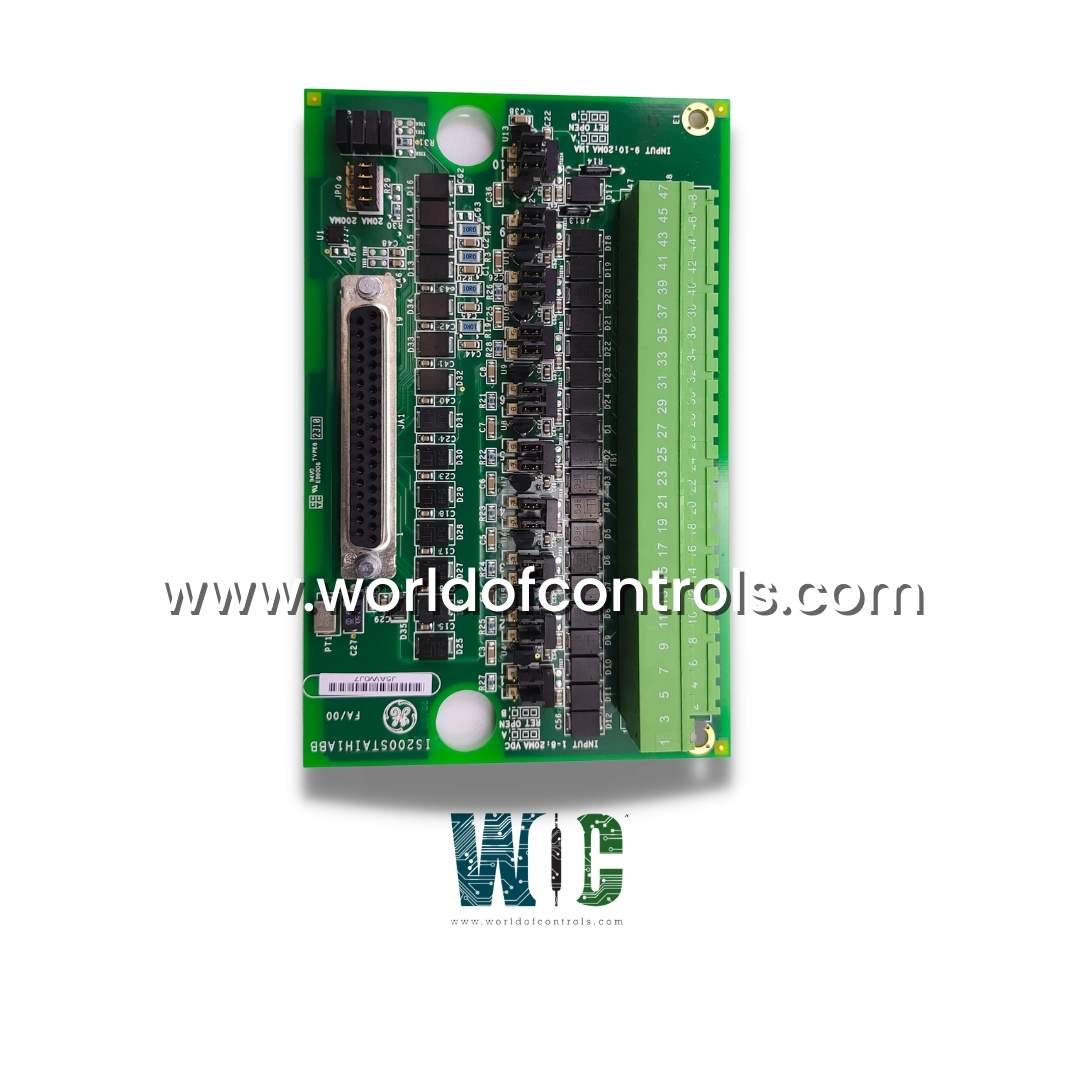SPECIFICATIONS
Part No.: IS200STAIS3A
Manufacturer: General Electric
Country of Manufacture: United States of America (USA)
Size: 15.9 cm high x 10.2 cm wide
Temperature: -30 to +65oC
Technology: Surface mount
Product Type: compact analog input terminal board
Availability: In Stock
Series: Mark VIe
Functional Description
IS200STAIS3A is a compact analog input terminal board developed by GE. It is a part of Mark VIe control system. The STAI board is equipped to handle up to 10 analog inputs, facilitating the integration of various types of transmitters. It accommodates two-wire, three-wire, four-wire, or externally powered transmitters, providing flexibility to adapt to different sensor configurations and signal types.
Product Features
- Analog Output Flexibility: In addition to analog inputs, the board offers two analog outputs, enabling the transmission of control signals or feedback data. These outputs are configured for 0-20 mA operation, with the option to jumper-configure one output to support 0-200 mA current, enhancing compatibility with diverse output devices and control systems.
- Simplex Configuration: The board is available exclusively in a simplex configuration, ensuring straightforward installation and operation within the system architecture. This streamlined design simplifies integration and minimizes complexity, making it ideal for applications requiring reliable analog signal processing without unnecessary features or complexities.
- Euro-Block Terminal Blocks: Features high-density Euro-block type terminal blocks, providing secure and reliable connections for analog input and output signals. These terminal blocks offer convenient wiring solutions, facilitating efficient installation and maintenance processes.
- On-Board Identification Chip: An on-board identification (ID) chip is integrated into the board, enabling seamless communication and system diagnostics with the PAIC (PAIC Pack). This ID chip ensures accurate identification of the board within the system architecture, facilitating troubleshooting and maintenance activities.
- Diagnostic Capabilities: By leveraging the onboard ID chip, the board enhances system diagnostic capabilities, allowing the PAIC to monitor and analyze board status and performance. This diagnostic functionality enables proactive identification of issues and it ensures optimal system reliability and performance.
Operation
- Streamlines the power supply provision process by offering 24 V dc power directly on the terminal board for all connected transmitters (transducers). This centralized power distribution simplifies wiring and ensures consistent power availability for all connected devices, enhancing operational reliability.
- Users can tailor input configurations according to their specific requirements by choosing between current or voltage inputs using jumper settings. This flexibility enables the board to accommodate diverse sensor types and signal formats, ensuring compatibility with various measurement applications and devices.
- Features two analog output circuits, each offering distinct configuration options. One output circuit is preset to deliver a standard 4-20 mA signal, while the other can be jumper-configured to support either a 4-20 mA or 0-200 mA output range. This versatility allows users to adapt the output signals to suit different control or monitoring systems, enhancing interoperability and functionality.
- With only one cable connection required, the board offers straightforward installation and connectivity. However, this singular cable connection precludes the use of redundant configurations such as Triple Modular Redundancy (TMR) applications, which rely on multiple independent connections for enhanced reliability. Unlike the TBAI (Triple Modular Redundancy Barrier Analog Input) board, the board prioritizes simplicity and streamlined operation over redundancy.
- Jumper settings play a crucial role in configuring the input and output parameters of the board. Users can utilize these jumpers to select the desired input type (current or voltage) and output range (4-20 mA or 0-200 mA), tailoring the board's functionality to specific application requirements. This customizable approach enhances flexibility and adaptability, allowing users to optimize performance for different operational scenarios.
Analog input terminal board Configuration
- Current or Voltage Input Selection: Jumpers J1A through J8A enable users to choose between current or voltage input for each of the 10 analog input channels. By configuring these jumpers, users can tailor the input type to match the requirements of the connected sensors or transducers.
- Return Connection Configuration: Jumpers J1B through J8B provide flexibility in configuring the return connection for each analog input channel. Users can select whether the return is connected to the common or left open, depending on the specific wiring and system requirements.
- Input Current Range Selection: Jumpers J9A and J10A allow users to select between 1 mA or 20 mA input current for specific input channels. This feature enables precise adjustment of input current levels to match the specifications of the connected transmitters or sensors.
- Return Connection Configuration for Input Current: Similar to the configuration for voltage inputs, jumpers J9B and J10B offer options for configuring the return connection for input currents. Users can choose between connecting the return to common or leaving it open, depending on system design and operational considerations.
- Output Current Range Configuration: Jumper J0 facilitates the configuration of output 1, allowing users to select between a 20 mA or 200 mA output current range. This jumper setting enables customization of the output signal characteristics to suit the requirements of the connected control or monitoring systems.
The WOC team is always available to help you with your Mark VIe requirements. For more information, please contact WOC.
Frequently Asked Questions
What is IS200STAIS3A?
It is a compact analog input terminal board developed by GE under the Mark VIe series.
How does the board monitor output current health?
The board utilizes a series resistor to gauge the voltage drop, indicating the output current. If either of the two outputs becomes unhealthy, the I/O processor triggers a diagnostic alarm.
How does the board ensure hardware compatibility?
Each cable connector on the terminal board features a unique ID chip containing essential details like the serial number, type, revision number, and connector locations. If a mismatch is detected when the I/O controller reads this chip, it generates a hardware incompatibility fault.
